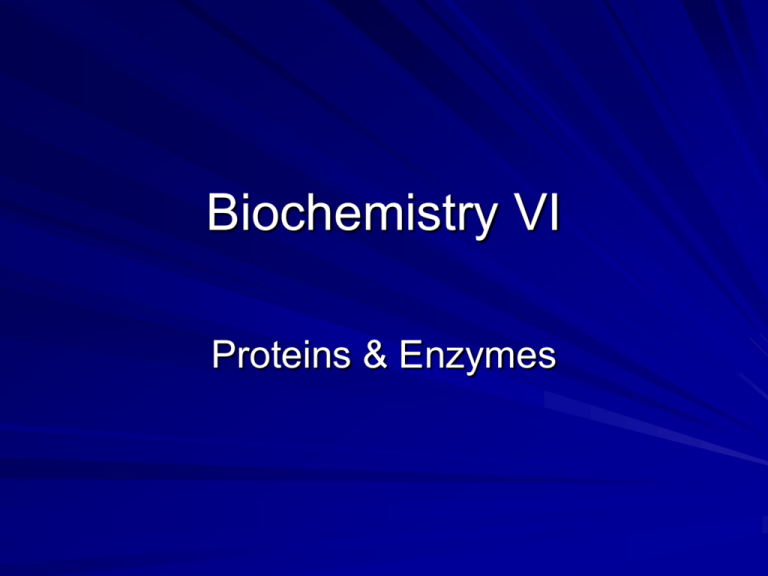Biochemistry VI
advertisement

Biochemistry VI Proteins & Enzymes Proteins Large, complex organic molecules Made of smaller monomers: Amino Acids Categories of proteins: – Structural Proteins – Storage Proteins – Transport Proteins – Defensive Proteins – Enzymes Structural Proteins Used to provide structure and support for certain parts of organisms Examples: – Keratin in hair/horns of animals – Collagen in connective tissues – Silk in spider webs Storage Proteins Used to store other molecules for later use Examples: – Casein in milk – Ovalbumin in egg whites – Zein in corn seeds Transport Proteins Used to assist in the transport of molecules into and out of a cell or other membrane Examples: – Hemoglobin (O2 carrier) in red blood cells – Integral membrane proteins Defensive Proteins Used to protect cells and organisms against foreign substances or life forms Examples: – Antibodies – Cell surface recognition proteins – Poisons made by plants, insects, snakes, etc. Enzymes Regulate the rate of chemical reactions Examples: – DNA polymerase and helicase – Lactase – Peroxidase – Sucrase Amino Acids The building blocks of proteins 20 total amino acids Some can be synthesized by humans, others must be consumed Carbon w/ 4 groups: Amine Carboxyl (acid) Hydrogen R group (varies) Amino Acid R Groups R Groups determine the physical and chemical properties of the protein They can be polar, nonpolar, acidic, or basic They can also be used for the attachment of other inorganic groups that are essential for the functioning of the protein – Heme group on hemoglobin bonds to Fe2+ – Other organic co-enzymes from our diet (vitamins) Putting Amino Acids Together To build a protein, the amino acids must be connected by peptide bonds Peptide bonds connect the amine group of one amino acid to the carboxyl group of the next This bond is caused by a dehydration reaction A chain of connected amino acids is called a polypeptide Where Do A.A.s Come From? Many foods contain amino acids in the form of protein When we digest protein, we recycle the amino acids and re-assemble them into our proteins Types of Amino Acids Structure of a Protein The code in the DNA recipe is a sequence of A’s, T’s, C’s and G’s The corresponding RNA copy of the recipe contains this code, which is read in 3’s – AUG, GGC, CUA, AAU, GCC, etc… Every 3 letter combination translates into 1 specific amino acid The chain of amino acids has a specific sequence Structure of Protein Primary Structure – A unique sequence of amino acids in a polypeptide chain Secondary Structure – Repeated folds and coils of a polypeptide chain Tertiary Structure – Irregular contortions from bonding of the side chains of the various amino acids Quaternary Structure – overall protein structure that results from the aggregation of tertiary subunits Website Animation http://www.learner.org/channel/courses/bio logy/units/proteo/images.html http://www.johnkyrk.com/aminoacid.html Enzymes Enzymes speed up metabolic reactions Enzymes: catalytic proteins Catalyst: reduces the activation energy Activation energy (Ea): energy required to start a reaction Enzymes Substrate: reactant an enzyme works on Active site: pocket where substrate is worked on Induced fit: brings chemical groups into positions that enhance their ability to work between the enzyme and substrate Effects of temperature and pH: enzymes have an optimal temperature and pH they work within Enzymes Cofactors: helpers bound into active site Coenzyme: an organic cofactor Competitive inhibitors: block the active site Non-competitive inhibitors: bind to another part of the enzyme, inhibiting work Allosteric site: receptor site away from the active site, where other molecules regulate activity Enzymes Feedback Inhibition: metabolic pathway is switched off by its end product Website Animations http://www.phschool.com/science/biology_ place/labbench/lab2/images/indfit.gif








